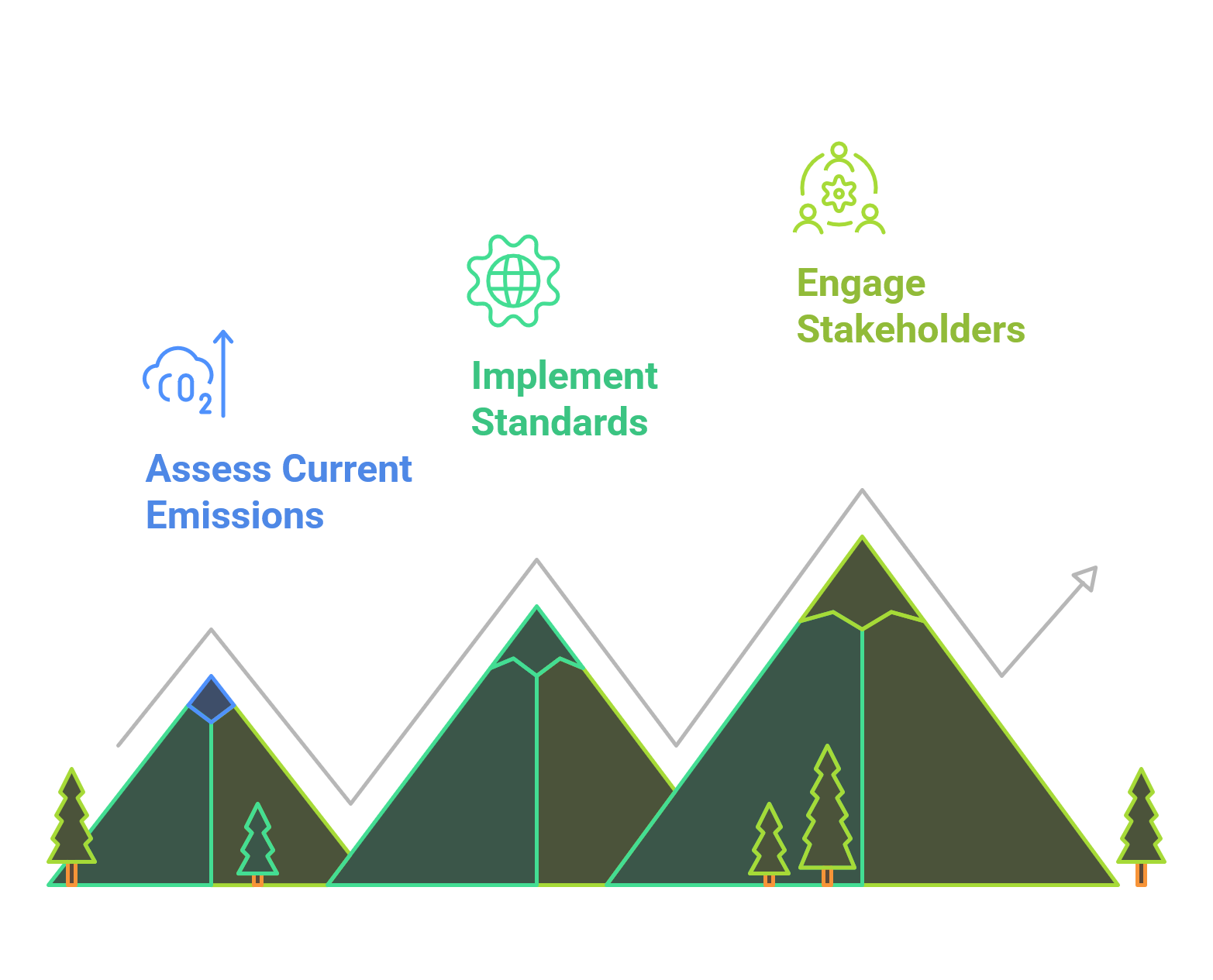Greenhouse Gas (GHG) Accounting: A Comprehensive Guide for Brands and Individuals

Reporting greenhouse gas (GHG) emissions is rapidly becoming a global mandate, with governments introducing stricter regulations to combat climate change across the world. At the same time, individuals are increasingly prioritizing greener choices, influencing markets and brands alike. As a result, more companies are embracing net-zero goals with an ambition to achieve them by 2050.
Now, the first step for anyone—whether you're an individual or a business—is understanding the emissions you generate, which helps build a solid foundation for meaningful climate action.
That’s why this guide (Carbon Accounting 101) delves into GHG carbon accounting’s essential concepts, methodologies, advantages, and best practices, offering the insights needed for a business or even an individual to start their transformative sustainability journey.
What is Greenhouse Gas (GHG) Emissions Accounting?
Greenhouse gas (GHG) accounting, also known as carbon accounting, is a method for businesses and organizations to measure and track the greenhouse gas emissions associated with their activities, operations, and value chains. It helps them understand their environmental impact.
By systematically measuring and quantifying GHG emissions, companies can benchmark their performance, ensure regulatory compliance, and set achievable reduction goals.
This comprehensive process empowers businesses to assess their carbon footprint and align their strategies with globally recognized sustainability standards, fostering accountability and transparency.
A few of the main Greenhouse Gases contributing to climate change are:
- Carbon Dioxide (CO2) - Primarily produced by the burning of fossil fuels (coal, oil, natural gas), as well as through deforestation and industrial processes like cement production.
- Methane (CH4) - Released during the extraction and transport of fossil fuels (natural gas and oil), agricultural activities (especially from livestock), landfills, and wastewater treatment.
- Nitrous Oxide (N2O) - Mainly emitted from agricultural activities, particularly from the use of synthetic fertilizers
- Fluorinated Gases (HFCs, PFCs, SF6) - These synthetic gases are primarily used in industrial applications such as refrigeration, and air conditioning, and as solvents in manufacturing processes.
Understanding the types of GHGs is just the beginning. To truly grasp the full impact of your emissions and take effective action, it is crucial to categorize them. This is where the concept of Emission Scopes—Scopes 1, 2, and 3—comes into play.
Scopes of Emissions
The Greenhouse Gas Protocol (one of the frameworks to measure GHG emissions) categorizes emissions into three scopes to ensure clarity and comprehensiveness in accounting processes:
- Scope 1️⃣: Direct emissions originating from owned or controlled sources, such as company vehicles and on-site fuel combustion.
- Scope 2️⃣: Indirect emissions resulting from purchased electricity, heat, or steam, reflecting the energy usage of an organization.
- Scope 3️⃣: A broader category encompassing all other indirect emissions within the value chain, including supplier activities and product usage.
Now that you understand a great deal about Greenhouse gas emissions and accounting, let’s take a quick second to understand why GHG accounting is important.
Importance of GHG Accounting
The primary objectives of GHG accounting are to:
🌱Gain a clear understanding of an organization’s carbon footprint.
🌱Identify strategic opportunities for emissions reduction.
🌱Manage any possible risks associated with evolving sustainability regulations
🌱Foster transparency and credibility with stakeholders, investors, and customers.
🌱Ensure alignment with evolving sustainability regulations and industry frameworks.
Having understood the need to keep an eye on your GHG emissions, let’s try and understand how one can get started with Carbon Accounting or Greenhouse Gas Accounting.
How to Get Started with Carbon Accounting
Embarking on your carbon accounting journey involves several key steps:

- Assess Current Emissions: Conduct a thorough baseline assessment across all scopes to establish a starting point.
- Implement Standards: Align with globally recognized frameworks like the Greenhouse Gas Protocol to ensure credibility.
- Engage Stakeholders: Foster collaboration and education among internal teams, suppliers, and partners.
We’ve already glimpsed into different sources of emissions, now let’s understand the nuances behind gathering and managing data, methodologies and frameworks of carbon accounting and reporting.
Data Collection and Reporting
Accurate data collection and transparent reporting are critical in carbon accounting to quantify emissions reliably, track progress over time, and build trust with stakeholders through actionable and verifiable insights.
Data Collection
- Activity Data: Quantifiable inputs like fuel consumption, electricity usage, raw material inputs, and travel distances.
- Emission Factors: Standardized coefficients (e.g., kg CO2e per kWh) to calculate emissions from activity data.
- Scope Categorization: Data is segmented by Scope 1 (direct emissions), Scope 2 (indirect energy emissions), and Scope 3 (value chain emissions).
- Temporal Boundaries: Ensure data is collected for a consistent time frame (e.g., annually) to align with reporting cycles.
- Data Sources: Use verified primary data (e.g., utility bills, meter readings) whenever possible; secondary data (e.g., industry averages) is a fallback.
- Granularity: Gather data at the most granular level feasible to enhance accuracy (e.g., by site or process).
Data Reporting
- Accuracy: Use verified methodologies like the Greenhouse Gas Protocol or ISO 14064 to ensure emissions are reported reliably.
- Transparency: Disclose assumptions, data sources, and calculation methodologies.
- Consistency: Follow consistent reporting standards year-on-year to track progress effectively.
- Materiality: Focus on reporting emissions that are significant to the organization’s overall footprint.
- Verification: Engage third-party audits for independent validation of reported emissions data.
- Scope Breakdown: Report emissions by individual scopes to provide detailed insights into direct and indirect emissions.
Standards and Frameworks of Carbon Accounting
Adherence to established standards enhances the reliability and comparability of GHG accounting. Key frameworks include:
1. The Greenhouse Gas Protocol: The most extensively used and trusted standard for emissions measurement and reporting.
2. ISO 14064 and ISO14067: This standard offers specific requirements for quantifying and reporting GHG emissions at organizational and product levels. ISO 14067 focuses on product carbon footprints.
3. PAS 2050: A globally recognized standard for assessing the carbon footprint of products and services throughout their entire lifecycle
Implementing these frameworks ensures consistency, credibility, and transparency in emissions reporting and sustainability initiatives.
Benefits of GHG Accounting / Carbon Accounting
Incorporating Greenhouse Gas (GHG) accounting into business operations offers numerous benefits:
- Regulatory Compliance: Helps meet national and international emission regulations, avoiding penalties and ensuring alignment with legal mandates.
- Enhanced Reputation: Demonstrates commitment to sustainability, improving brand image and fostering trust with stakeholders.
- Strategic Decision-Making: Provides insights into emission hotspots, enabling informed strategies for efficiency and cost reduction.
- Risk Mitigation: Identifies potential climate-related risks in operations and supply chains, allowing proactive management.
- Cost Savings: Identifying inefficiencies can lead to reduced energy and resource consumption, cutting operational costs.
- Competitive Edge: Opens opportunities for green financing, partnerships, and access to environmentally focused markets.
These benefits make GHG accounting an essential tool for driving meaningful climate action and long-term organizational success.
What’s Trending in 2025 in GHG Accounting?
🔥 The landscape of carbon accounting is rapidly evolving, with several noteworthy trends:
1. Sector-Specific Decarbonization: Industries with high emissions, such as manufacturing and logistics, are adopting tailored strategies to curb their carbon footprints.
2. Carbon Offsetting and Credits: Growing interest in leveraging offsets to achieve carbon neutrality while supporting global climate initiatives.
3. Technology Integration: Emerging tools and AI-driven solutions are revolutionizing the accuracy and efficiency of emissions reporting.
🌍 In today’s sustainability-driven world, carbon accounting is not just a regulatory requirement but a business imperative. By adopting reliable methodologies, adhering to trusted standards, and prioritizing transparency, organizations can transform environmental responsibility into a significant competitive edge. GHG accounting not only mitigates risks but also fosters innovation, efficiency, and long-term value creation.
FAQs
1. Is there a difference between GHG accounting and carbon assessment?
- Yes, GHG accounting encompasses all greenhouse gases, while carbon assessments may focus specifically on CO2.
2. Can GHG accounting mitigate global warming?
- Indirectly, as it provides the actionable insights necessary to reduce emissions effectively.
3. How often should carbon accounting be conducted?
- Annually, with more frequent evaluations recommended for high-impact industries like fossil fuel, real estate, and such.
4. What are carbon credits and offsets?
- These mechanisms balance emissions by investing in environmental projects that sequester or reduce GHGs.
5. Can small businesses implement carbon accounting effectively?
- Absolutely, using streamlined tools and simplified methodologies designed for smaller-scale operations.

